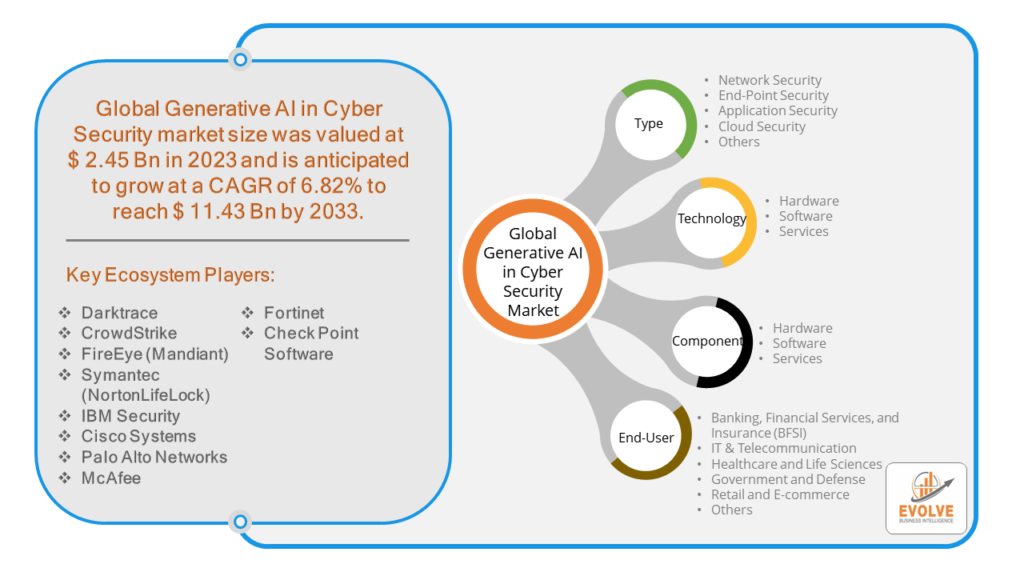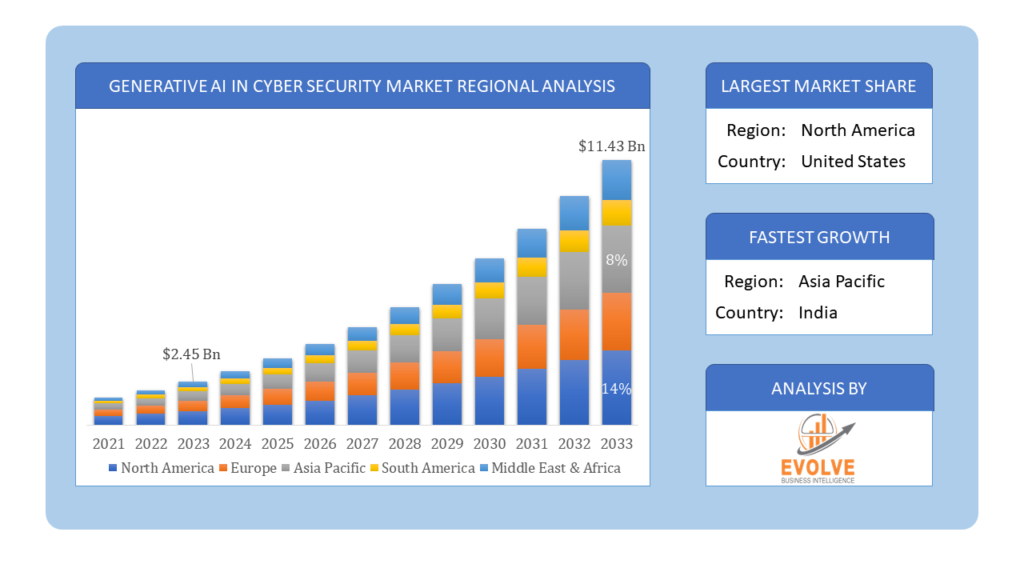Generative AI in Cyber Security Market Overview
Generative AI in Cyber Security Market Size is expected to reach USD 11.43 Billion by 2033. The Generative AI in Cyber Security industry size accounted for USD 2.45 Billion in 2023 and is expected to expand at a compound annual growth rate (CAGR) of 6.82% from 2023 to 2033. The generative AI in cybersecurity market involves the application of artificial intelligence techniques, particularly generative models like GANs (Generative Adversarial Networks), to enhance security measures. These AI systems create and analyze data to identify vulnerabilities, simulate attacks, and develop proactive defense strategies. Key applications include threat detection, anomaly identification, and automated response systems, aiming to strengthen defenses against evolving cyber threats. Market growth is driven by increasing cyberattacks, the complexity of digital environments, and the need for adaptive, real-time security solutions. Major players in this field focus on developing sophisticated AI algorithms and platforms tailored to address specific cybersecurity challenges.
Global Generative AI in Cyber Security Market Synopsis
The COVID-19 pandemic has led to supply chain disruptions leading to supply shortages or lower demand in the E-commerce market. The travel restrictions and social-distancing measures have resulted in a sharp drop in consumer and business spending and this pattern is to continue for some time. The end-user trend and preferences have changed due to the pandemic and have resulted in manufacturers, developers, and service providers to adopt various strategies to stabilize the company.
Global Generative AI in Cyber Security Market Dynamics
The major factors that have impacted the growth of Generative AI in Cyber Security are as follows:
Drivers:
⮚ Advancements in AI Technology
Rapid advancements in artificial intelligence, particularly in generative models like GANs (Generative Adversarial Networks) and reinforcement learning, empower cybersecurity systems to learn from vast datasets and adapt to new attack methods in real-time. This capability enhances the efficacy and agility of defense mechanisms.
Restraint:
- Data Privacy Concerns
Generative AI systems require access to large datasets for training, which may include sensitive information. Privacy regulations such as GDPR and CCPA impose strict requirements on data handling and usage, complicating compliance and potentially limiting data availability for training purposes.
Opportunity:
⮚ Development of AI-Driven Security Products
Innovations in generative AI technologies fuel the development of new security products and services. This includes AI-driven threat intelligence platforms, automated penetration testing tools, and adaptive security frameworks that cater to diverse industry verticals.
Generative AI in Cyber Security Market Segment Overview
By Type
 Based on the Type, the market is segmented based on Network Security, End-Point Security, Application Security, Cloud Security and Others. Based on the Type, the market is segmented based on Network Security, End-Point Security, Application Security, Cloud Security and Others.
Based on the Type, the market is segmented based on Network Security, End-Point Security, Application Security, Cloud Security and Others. Based on the Type, the market is segmented based on Network Security, End-Point Security, Application Security, Cloud Security and Others.
By Technology
Based on Technology, the market has been divided into Generative Adversarial Networks (GANs), Variational Auto-encoders (VAEs), Reinforcement, Learning (RL), Deep Neural Networks (DNNs), Natural Language Processing (NLP) and Others. Based on Technology, the market has been divided into Generative Adversarial Networks (GANs), Variational Auto-encoders (VAEs), Reinforcement, Learning (RL), Deep Neural Networks (DNNs), Natural Language Processing (NLP) and Others.
By Component
Based on the Component, the market has been divided into Hardware, Software and Services. Based on the Component, the market has been divided into Hardware, Software and Services.
By End-User
Based on End-User, the market has been divided into Banking, Financial Services, and Insurance (BFSI), IT & Telecommunication, Healthcare and Life Sciences, Government and Defense, Retail and E-commerce and Others. Based on End-User, the market has been divided into Banking, Financial Services, and Insurance (BFSI), IT & Telecommunication, Healthcare and Life Sciences, Government and Defense, Retail and E-commerce and Others
Global Generative AI in Cyber Security Market Regional Analysis
Based on region, the market has been divided into North America, Europe, Asia-Pacific, the Middle East & Africa, and Latin America. The area of North America is anticipated to dominate the market for the usage of Generative AI in Cyber Security, followed by those in Asia-Pacific and Europe.
 Global Generative AI in Cyber Security North America Market
Global Generative AI in Cyber Security North America Market
The North American region holds a dominant position in the Generative AI in Cyber Security market. North America is a significant region in the generative AI in cybersecurity market, driven by advanced technological adoption and stringent regulatory frameworks. The region’s dominance is attributed to the presence of major cybersecurity firms, extensive investments in AI research and development, and a high incidence of cyber threats across various industries including BFSI, healthcare, and government sectors. Key factors contributing to market growth in North America include increasing cyberattacks, regulatory compliance pressures such as GDPR and CCPA, and the proactive adoption of AI-driven security solutions to enhance threat detection and response capabilities. The region’s robust cybersecurity infrastructure and proactive measures against emerging threats position it as a leading market for generative AI technologies in cybersecurity.
Global Generative AI in Cyber Security Asia Pacific Market
The Asia-Pacific region is witnessing rapid growth and emerging as a significant market for the Generative AI in Cyber Security industry. Asia Pacific is a burgeoning region in the generative AI in cybersecurity market, driven by rapid digital transformation and increasing cyber threats. Countries like China, Japan, and India are witnessing significant adoption of AI-driven cybersecurity solutions across industries such as banking, IT, and healthcare. The region benefits from growing investments in AI technologies, supportive government initiatives, and a rising awareness of cybersecurity risks. Key drivers include the expansion of cloud computing, IoT adoption, and the need for robust data protection measures. Despite these opportunities, challenges such as data privacy concerns and varying regulatory landscapes across countries may impact market growth and adoption rates in Asia Pacific.
Competitive Landscape
The competitive landscape includes key players (tier 1, tier 2, and local) having a presence across the globe. Companies such as Darktrace, CrowdStrike, FireEye (Mandiant), Symantec (NortonLifeLock), and IBM Security are some of the leading players in the global Generative AI in Cyber Security Industry. These players have adopted partnership, acquisition, expansion, and new product development, among others as their key strategies.
Key Market Players:
- Darktrace
- CrowdStrike
- FireEye (Mandiant)
- Symantec (NortonLifeLock)
- IBM Security
- Cisco Systems
- Palo Alto Networks
- McAfee
- Fortinet
- Check Point Software
Key Development:
In September 2022, IBM Security introduced enhanced AI capabilities focused on threat detection and response, aiming to strengthen its cybersecurity offerings with advanced machine learning algorithms and proactive security measures.
Scope of the Report
Global Generative AI in Cyber Security Market, by Type
- Network Security
- End-Point Security
- Application Security
- Cloud Security
- Others
Global Generative AI in Cyber Security Market, by Technology
- Generative Adversarial Networks (GANs)
- Variational Auto-encoders (VAEs)
- Reinforcement Learning (RL)
- Deep Neural Networks (DNNs)
- Natural Language Processing (NLP)
- Others
Global Generative AI in Cyber Security Market, by Component
- Hardware
- Software
- Services
Global Generative AI in Cyber Security Market, by End-User
- Banking, Financial Services, and Insurance (BFSI)
- IT & Telecommunication
- Healthcare and Life Sciences
- Government and Defense
- Retail and E-commerce
- Others
Global Generative AI in Cyber Security Market, by Region
- North America
- US
- Canada
- Mexico
- Europe
- UK
- Germany
- France
- Italy
- Spain
- Benelux
- Nordic
- Rest of Europe
- Asia Pacific
- China
- Japan
- South Korea
- Indonesia
- Austalia
- Malaysia
- India
- Rest of Asia Pacific
- South America
- Brazil
- Argentina
- Rest of South America
- Middle East & Africa
- Saudi Arabia
- UAE
- Egypt
- South Africa
- Rest of Middle East & Africa
| Parameters | Indicators |
|---|---|
| Market Size | 2033: $11.43 Billion |
| CAGR | 6.82% CAGR (2023-2033) |
| Base year | 2022 |
| Forecast Period | 2023-2033 |
| Historical Data | 2021 |
| Report Coverage | Revenue Forecast, Competitive Landscape, Growth Factors, and Trends |
| Key Segmentations | Type, Technology, Component, End-User |
| Geographies Covered | North America, Europe, Asia-Pacific, Latin America, Middle East, Africa |
| Key Vendors | Darktrace, CrowdStrike, FireEye (Mandiant), Symantec (NortonLifeLock), IBM Security, Cisco Systems, Palo Alto Networks, McAfee, Fortinet, Check Point Software |
| Key Market Opportunities | Growing E-commerce Industry |
| Key Market Drivers | Increasing Consumer Demand Technological Advancements |
REPORT CONTENT BRIEF:
- High-level analysis of the current and future Generative AI in Cyber Security Industry trends and opportunities
- Detailed analysis of current market drivers, restraining factors, and opportunities analysis in the future
- Historical market size for the year 2021, and forecast from 2023 to 2033
- Generative AI in Cyber Security market share analysis for each segment
- Competitor analysis with a comprehensive insight into its product segment, financial strength, and strategies adopted.
- Identifies key strategies adopted by the key players including new product development, mergers and acquisitions, joint ventures, collaborations, and partnerships.
- To identify and understand the various factors involved in the global Generative AI in Cyber Security market affected by the pandemic
- To provide year-on-year growth from 2022 to 2033
- To provide short-term, long-term, and overall CAGR comparison from 2022 to 2033.
- Provide Total Addressable Market (TAM) for the Global Generative AI in Cyber Security Market.








